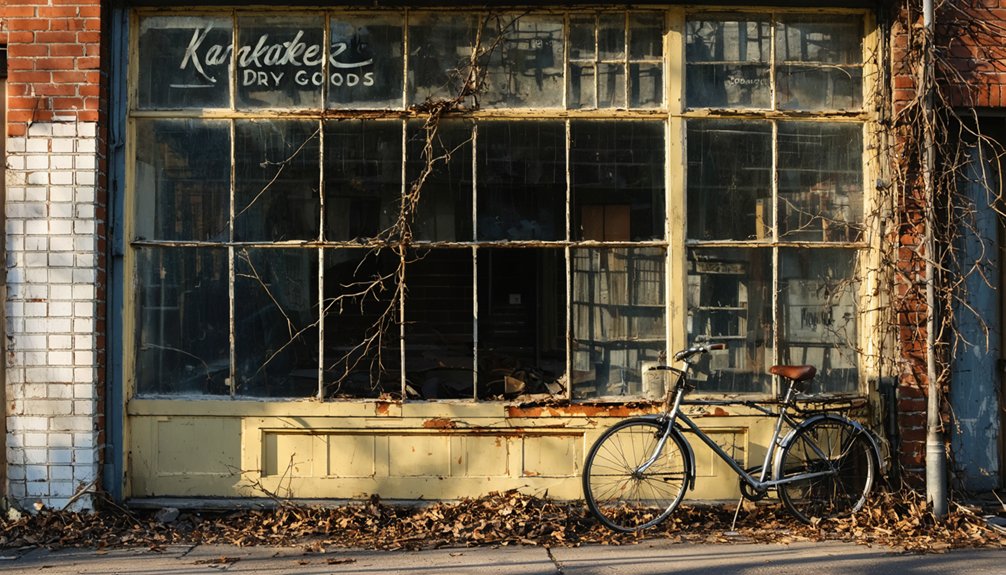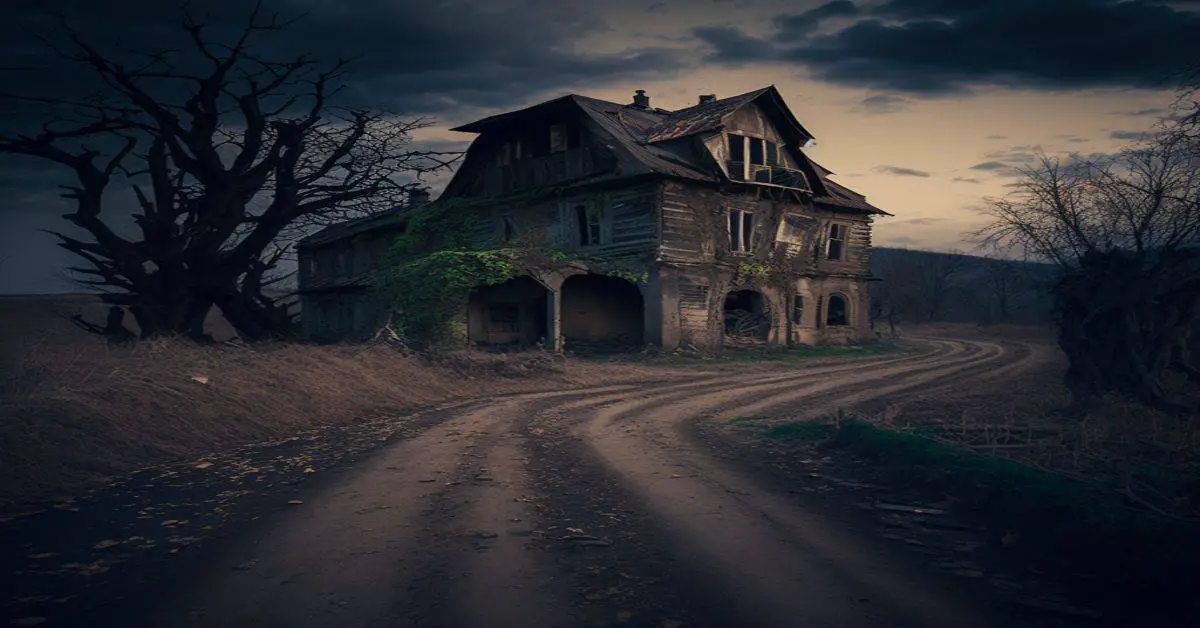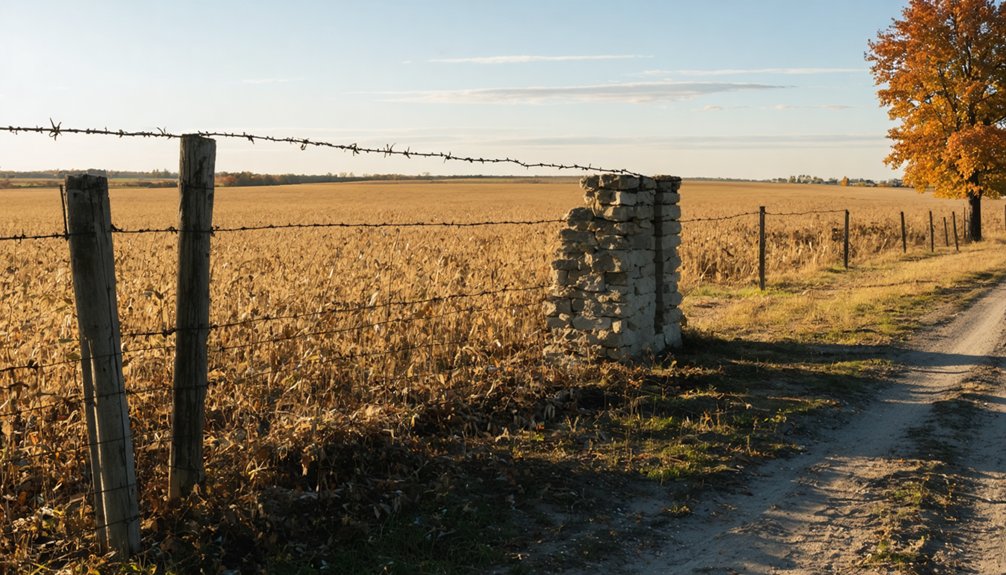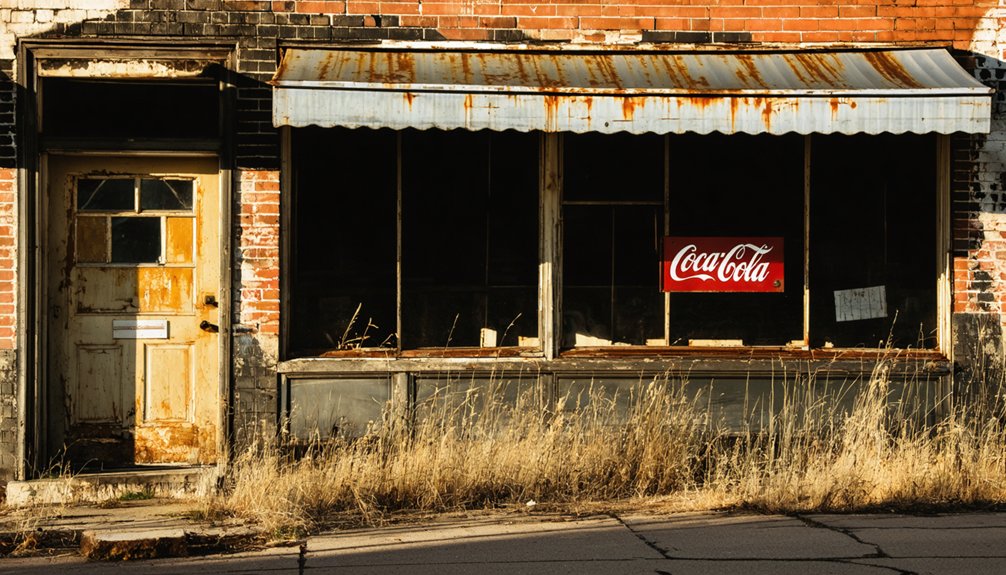You’ll find Kankakee City’s transformation from bustling river town to ghost settlement reflects America’s industrial evolution. Once home to Potawatomi Indians, French fur traders established posts along the Kankakee River in the 1700s. The arrival of the Illinois Central Railroad in 1853 shifted economic activity away from the river, leaving original settlements abandoned. Today, abandoned structures, mysterious railroad tracks, and the haunted Majestic Center Theater tell tales of this forgotten chapter in Illinois history.
Key Takeaways
- Kankakee City transformed from a river-based settlement to a railroad hub in 1853, causing original riverside communities to become ghost towns.
- The decline of steamboat trade and drainage of the Kankakee Marsh led to abandonment of early river settlements.
- Ghost settlements like Freilings and Wauponsee emerged and disappeared along the defunct Kankakee & Seneca Railroad route.
- Physical traces of abandoned rail beds and structures mark locations of former ghost settlements throughout Kankakee County.
- The shift from river to rail transportation created new economic centers, leaving original river settlements to fade into history.
Origins of Early Settlement and Native American Heritage
While the Kankakee River Valley now stands as a reflection of modern development, it first flourished as the ancestral homeland of the Potawatomi Indians, who recognized the area’s strategic value for settlement.
You’ll find their Native heritage deeply embedded in the landscape – from the rolling terrain and oak groves to the limestone bluffs and interconnected waterways that sustained their way of life.
The cultural significance of this region extends beyond the Potawatomi. By 1679, French explorer La Salle navigated these waters, marking the beginning of European contact.
La Salle’s 1679 voyage through these sacred waters opened a new chapter, bridging Native American and European worlds forever.
Soon after, French-Canadian fur traders like Gurdon Hubbard and Noel LeVasseur established trading relationships with the indigenous communities.
Through the 1832 Treaty of Camp Tippecanoe, this vibrant Native homeland transformed into settler territory, forever changing the valley’s destiny. As early as 1834 settlers arrived, bringing significant changes to the region’s demographic landscape.
Log houses became the primary dwellings for these early pioneers, who often shared living spaces with multiple families as they established their new homes.
The Rise and Fall of a River Town
You’ll find that Kankakee City’s early prosperity was closely tied to its strategic location along the Kankakee River, where French Canadian fur traders like Noel Le Vasseur established lucrative trading posts in the early 19th century.
The town’s growth accelerated after 1847 when the Kankakee & Iroquois Navigation Company developed water routes connecting to the Illinois & Michigan Canal, establishing a thriving steamboat industry that made Kankakee the region’s commercial hub.
However, the arrival of the Wabash Railroad in the 1880s, coupled with the massive drainage projects of 1899-1917 that transformed the river into a straight channel, dealt a devastating blow to the river-based economy that had sustained the town’s early success. The region’s transformation was particularly stark, as the original Kankakee Marsh had once covered 600,000 acres of wetlands that supported countless wildlife species. The area’s landscape was shaped during the last ice age when the Wisconsin Glacial Episode created distinct features including moraines and outwash plains.
Early Settlement Origins
Long before Kankakee City emerged as a settlement, French explorer Rene Robert Cavelier, Sieur de La Salle, traversed the portage between the St. Joseph and Kankakee Rivers in 1679.
French influence soon took root as French-Canadian fur traders, including Noel LeVasseur, established the first permanent European presence in the area. Following the French settlement pattern, early communities formed around Jesuit missions and trading posts.
You’ll find that the region’s original inhabitants, the Potawatomi Indians, thrived along the Kankakee River’s rich hunting and fishing grounds.
However, their way of life changed dramatically after the 1832 Treaty of Camp Tippecanoe, which began the process of native displacement.
By 1835, new settlers faced harsh realities: food shortages plagued the community, and blackbirds devastated what few crops they managed to plant.
Significant farming didn’t begin until after the 1838 land sale.
The arrival of the Illinois Central Railroad in 1853 marked a turning point, transforming the quiet prairie into a developing settlement.
River Trade Prosperity
The bustling fur trade of the Kankakee River Valley transformed a wilderness outpost into a thriving commercial hub by the early 1700s.
You’d find French traders like Le Vasseur and Bourbonnais establishing strategic posts along the river’s edge, exchanging European goods for valuable Potawatomi pelts.
The river’s economic shifts reflected the changing tides of commerce in the Old Northwest.
By the 1820s, river commerce had expanded beyond furs to include agricultural goods and supplies for growing settlements.
The historical route served as a vital Great Lakes-Mississippi link, connecting major waterways for travelers and missionaries.
You could witness boats laden with trade goods maneuvering between the Great Lakes and Mississippi, while Governor Vaudreuil’s policies strengthened French-Native partnerships.
The arrival of the Illinois Central Railroad in 1853 marked a new era of transportation and trade for the region.
The Kankakee & Iroquois Navigation Company’s 1847 charter marked the peak of waterborne trade, though this prosperity wouldn’t last as railroads began reshaping the region’s economic landscape.
Transportation Shifts Impact
While river commerce flourished in early Kankakee, transformative changes in transportation would alter the town’s destiny forever.
You’ll find the town’s transportation evolution marked by the arrival of major railroads, including the Kankakee & Illinois River Railroad and the New York Central’s Kankakee Belt Route. These rail lines connected the region to essential hubs like Chicago and South Bend, offering faster and more reliable year-round service than river transport. Like the naval vessel Kankakee that achieved 17.0 knots at sea, the town’s transportation systems evolved to prioritize speed and efficiency.
Between 1899 and 1917, you’d see dramatic changes as the Kankakee River underwent extensive channelization. The Grand Kankakee Marsh, once the largest wetland in North America, would disappear as development progressed.
The construction of dams and the dredging of 72 miles transformed the once-navigable waterway into a straightened ditch. This regional development prioritized agriculture and drainage over river commerce, effectively ending Kankakee’s role as a river transportation hub in favor of land-based infrastructure.
Railroad Impact and Economic Transformation
You’ll find Kankakee’s transformation from a modest settlement to a bustling rail hub began with the arrival of the Illinois Central Railroad in 1853, which established a critical junction point that attracted significant economic activity.
The strategic placement of rail yards and the convergence of major railway lines, including the Big Four Railway and the New York Central’s Kankakee Belt Route, sparked rapid population growth as businesses and workers migrated to the area.
While the original settlement patterns shifted to follow the railway development, several smaller communities near the original river routes became ghost settlements as economic activity concentrated around the new rail corridors.
Railroad Junction Development Patterns
Since its founding by Illinois Central Railroad in 1853, Kankakee’s development followed classic junction-town patterns, with rail infrastructure driving rapid economic growth and urban expansion.
The railroad junctions shaped urban patterns through strategic placement of yards, maintenance facilities, and industrial corridors.
Key development features you’ll notice:
- A 49-block grid layout emerged around the rail convergence points, maximizing access to transportation.
- Industries clustered near rail yards, with grain elevators, lumber yards, and quarry operations positioning themselves for efficient loading.
- Rail-driven growth extended beyond downtown as streetcar lines enabled expansion into Bradley and Bourbonnais.
The major rail companies’ joint operations through Kankakee created a robust transportation network that determined land use patterns and industrial zones, forever shaping the city’s layout and economic destiny.
Economic Migration After Tracks
As the railroad tracks transformed Kankakee’s landscape in the mid-1800s, the city experienced dramatic economic shifts that would define its future for generations.
You’d have seen waves of settlers from the East Coast drawn to the area’s economic opportunities, with pioneers like Lemuel Milk establishing expansive agricultural operations that shaped settlement patterns.
While the railroads initially brought prosperity, you’ll notice how they also contributed to the area’s eventual decline.
The story of Tracy, a small coal mining settlement that vanished by 1900, shows you how quickly fortunes could change.
Later, you’d witness Kankakee’s industrial boom fade as major employers like General Foods and Roper closed their doors.
Though the city unexpectedly evolved into a biotech hub, it couldn’t fully recover from the manufacturing exodus that reshaped its economic landscape.
Ghost Settlements Near Railways
When the Illinois Central Railroad established Kankakee in 1853, it sparked a wave of railway development that would transform the region’s landscape.
You’ll find ghostly encounters with the past along abandoned rights-of-way where towns like Freilings and Wauponsee once thrived before the Kankakee & Seneca Railroad’s demise in 1933.
Railway memories persist in these forgotten settlements:
- The 48.5-mile Kankakee & Seneca line connected essential communities like Bonfield, Union Hill, and Gardner.
- Towns that sprouted around track junctions flourished with commerce until route abandonments.
- Physical traces of rail beds still mark where ghost settlements stood, revealing how railway infrastructure shaped local development.
These vanished communities tell a stark tale of how railroad consolidations and economic shifts stripped small towns of their lifeblood, leaving only traces of their former vibrancy.
Haunted Landmarks and Local Ghost Stories
Throughout Kankakee’s rich history, numerous haunted landmarks and ghost stories have woven themselves into the city’s cultural fabric.
You’ll find the legendary Majestic Center Theater, where two spirits, including original builder Julie Remmington, are said to roam its historic halls.
The infamous Manteno State Hospital, closed since 1985, draws ghost hunters with its dark history of typhoid outbreaks and reports of lingering patient spirits in its underground tunnels.
Local railroad tracks bear witness to mysterious phenomena, with tales of children’s laughter and unexplained handprints on cars.
The haunted farmhouse on Old Limestone Road keeps alive the story of James Robinson, a Civil War soldier who never returned.
These landmarks, along with abandoned structures from former ghost towns, continue to fuel Kankakee’s reputation as a haven for paranormal activity.
Agricultural Legacy of Lemuel Milk
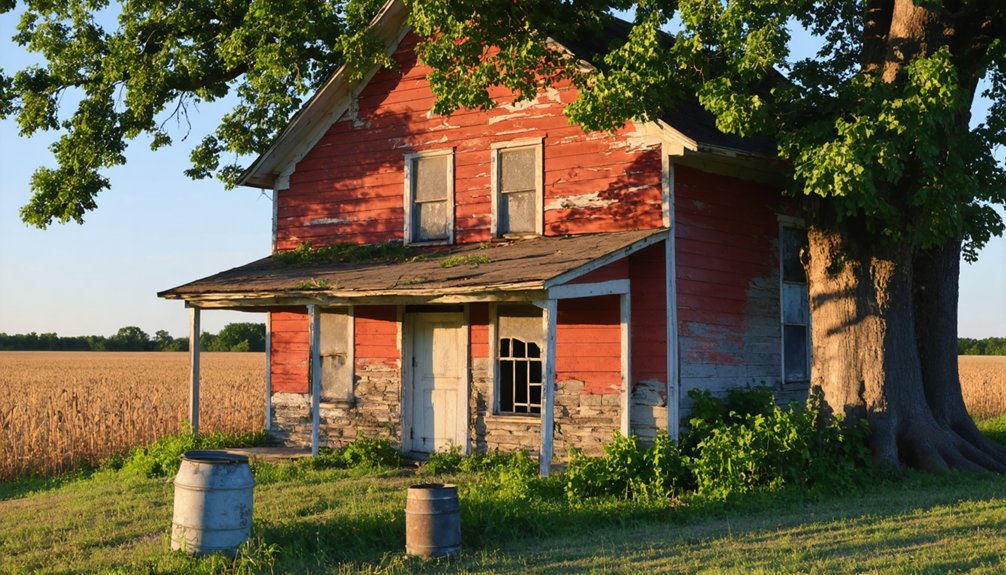
Standing among Eastern Illinois’s most influential agricultural pioneers, Lemuel Milk transformed the region’s farming landscape through his experimental practices and vast land development initiatives.
His innovations revolutionized local agriculture as he drained wet prairies and established tenant farms across his 25,000-acre empire spanning Illinois, Indiana, and North Dakota.
Lemuel Milk’s Innovations and Agricultural Impact continue to shape the region through:
A pioneering force in Midwestern agriculture, Lemuel Milk’s innovative farming methods and land development strategies continue influencing regional practices today.
- Experimental farming methods that intensified agricultural production
- Strategic drainage of wetlands to create more tillable farmland
- Development of tenant farming systems focused on livestock and grain
You can still witness his legacy in Milks Grove Township, where his agricultural vision helped establish the region’s farming foundation.
His strategic approach to land development and farming practices set new standards for agricultural entrepreneurship in the Midwest.
Decline of Neighboring Ghost Communities
As the 19th century drew to a close, several small settlements near Kankakee City faced dramatic decline due to their heavy reliance on single industries.
You’ll find Tracy’s story particularly telling – a coal mining settlement that vanished around 1900 after its crucial coal seam was depleted. The town’s dozen buildings emptied as residents fled economic isolation.
The ghost town causes weren’t limited to resource exhaustion. Railroad changes hit these communities hard, with reduced rail service cutting off essential market access.
Towns like Shermanville, dependent on limestone quarrying, couldn’t survive without economic diversification. Environmental challenges, including the draining of the Grand Kankakee Marsh, further pressured these vulnerable settlements.
When schools and businesses shuttered, the remaining residents had little choice but to seek opportunities elsewhere.
Urban Decay and Modern Day Remnants
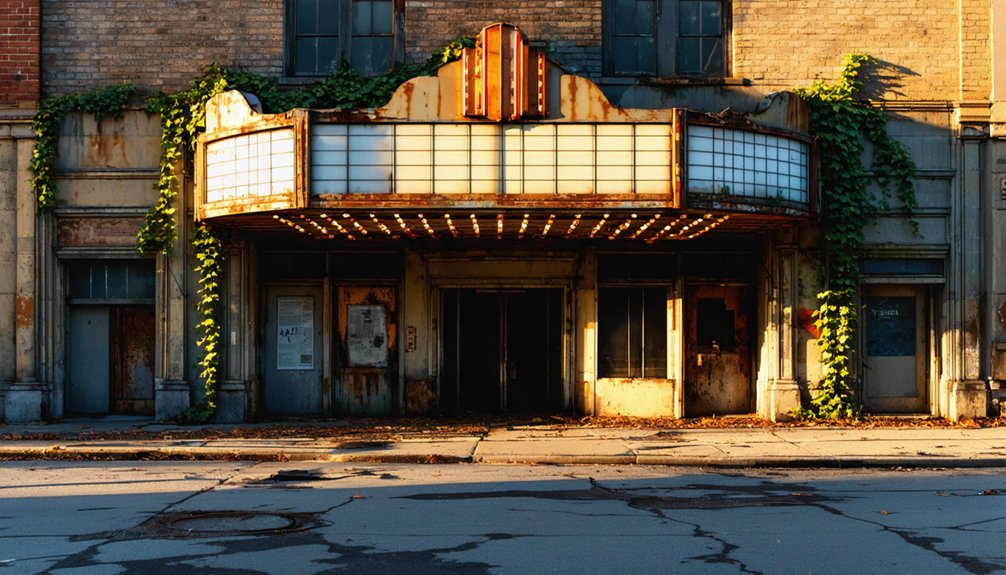
Similar patterns of decline that plagued neighboring settlements eventually reached Kankakee City itself, transforming once-bustling districts into shadows of their former glory.
You’ll find stark evidence of urban decay in the downtown core, where major retailers abandoned their storefronts following the 1970s suburbanization trend.
Key remnants of Kankakee’s past include:
- The Downtown Historic District, still showcasing original architectural features despite surrounding deterioration
- The abandoned Volkmann Building site, demolished in 1991, marking the city’s infrastructural decline
- The Riverview Historic District, Kankakee’s oldest intact residential neighborhood, standing defiant against decay
Today, you can witness the city’s struggle between preservation and decline, with biotech development offering a glimmer of hope amid vacant industrial complexes and economic challenges that earned Kankakee its unfortunate reputation in 1999.
Frequently Asked Questions
What Happened to the Original Native American Burial Grounds in Kankakee?
You’ll find most Native American burial grounds in Kankakee were lost to farming, development, and erosion. Preservation efforts came too late, as European settlement disrupted these sacred sites during the 1800s.
Are There Any Accessible Underground Tunnels Still Remaining From Historic Kankakee?
You won’t find accessible historic tunnels today. While utility passages exist at the former state hospitals, they’re closed for historic preservation and safety reasons. Urban exploration here isn’t legally permitted.
How Many People Still Live in Kankakee’s Abandoned Ghost Town Areas?
You won’t find true ghost towns in Kankakee proper, though abandoned homes exist amid population decline. While some neighborhoods are sparsely populated, there’s no official count of residents in declining areas.
What Natural Disasters Contributed to Kankakee’s Decline as a Settlement?
While you might expect flood damage or tornado destruction played a major role, research shows natural disasters didn’t cause Kankakee’s decline – it was primarily economic factors and industrial collapse.
Where Can Visitors Find Artifacts From Kankakee’s French Voyageur Period?
You’ll find French artifacts and Voyageur history at the French Heritage Museum in the Stone Barn, Kankakee County Historical Society, and Bourbonnais Grove Historical Society. Most exhibits offer free admission.
References
- https://kankakeecountymuseum.wordpress.com/tag/ghost-stories/
- http://www.kankakeevalleyhistoricalsociety.org/Kankakee River History/Books and papers/Tales of an old bordertown and along the Kankakee.pdf
- https://www.lowellpl.lib.in.us/lowell-history-pages/the-ghost-town-of-northwest-indiana/
- https://www.youtube.com/watch?v=n6iuUZlTWGg
- https://raddoc1947.com/2016/11/18/canal-ghost-towns/
- https://citykankakee-il.gov/post_custom.php?s=2018-01-26-the-founding-of-kankakee
- https://en.wikipedia.org/wiki/List_of_ghost_towns_in_Illinois
- https://www.villageofbourbonnais.com/visit-kankakee-county/a-few-facts-about-kankakee-county
- http://genealogytrails.com/ill/kankakee/history_settlers.html
- https://illinoisgenweb.org/history/early-illinois-history.html
